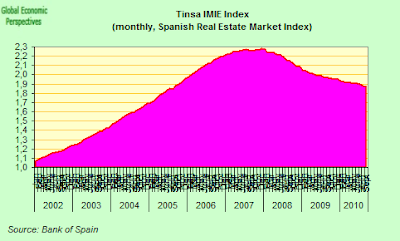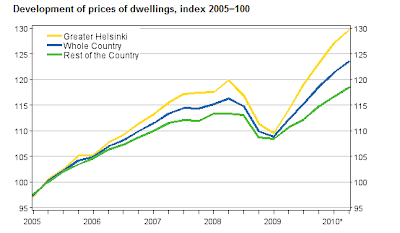By Claus Vistesen: Hull
Update: I was so caught up with Ireland today that I didn't notice how Greece also wants its part of the limelight. But fear not; Joseph Cotterhill from Alphaville delivers the goods as Greek spreads to the German benchmark rose above 10%. Basically, it is a mess at the moment in Greece with one of the biggest risks that the political balance is also shifting. Most remarkably however was the comments made by the Finance Minister Papaconstantinou that growth rate this year would be -4.0 and -2.5 to -3.0 in 2011. Add to this ongoing deficits (which will of course be smaller due to the contraction) and you are looking at an overall debt level that does not look too nice at all. Basically, the 2009 deficit is likely to be revised to 15% of GDP by the EU commission according to Alphaville and the IMF puts the 2010 deficit to around 7%. Now, figures are scarce here but wikipedia puts debt to GDP at 115% in 2009. So, with let us say a 5% deficit in 2011, a nominal growth rate of -2.5% and an initial debt level of 115% (just to play nice) my calculations suggest that Greece will be facing a debt to GDP level of some 130% at the end of 2011, a number which naturally will grow as we move on.
---
Popular wisdom has it that markets are always right or, more appropriately; that if you find your self on the wrong side of the market consensus the best cause of action is to join the ranks less you want to be rolled over by steamroller. However, it may take some time before the market corrects to the underlying fundamentals or so, at least, I will argue.
Last time I wrote on Ireland I noted how the country's latest move to emphasize its strong cash position (as well as the fact that it announced the intention not to go to market to seek financing) was a wink to EU policy makers that either the current plan works or Ireland will need funding help. Private market funding at current and future expected rates is not an option and the really important question is whether the interest rates charge by some form of European SPV would also be consistent with a recovery or simply another debt spiral. I have my doubts here.
Indeed; with a the running deficit to GDP of 32% in 2010 it is absolutely necessary that Ireland addresses this as a first priority. No matter how much cash you have lying around or how much you expect to be able to get from a coordinated relief program (essentially borrowing with low rates and long maturity), the failure to react now would mean that the time path of public debt would prove instantly unsustainble as we moved into 2011 and 2012
However, markets don't seem to be very comfortable with the prospects of very strong austerity measurse in Ireland.
Quote Bloomberg
Bond investors are losing faith in Ireland’s plan to lower the deficit as spending cuts threaten to undermine economic growth, reducing government revenue. Irish 10-year bond yields climbed within 50 basis points of the 454 basis-point record spread, set Sept. 29, relative to similar-maturity German bunds. Portugal’s spread fell about 1 percentage point against the German benchmark in the past month, the Greek-German yield gap narrowed 102 basis points and the Spanish spread was close to the lowest level since Aug. 10.
It is important to understand the underlying message here. What drives the worry is not so much the debt and deficit itself, but more so that the severe austerity measures needed to restore the evolution of debt will derail the economy and thus become counterproductive. Indeed, this is the main issue which most OECD economies grapple with at the moment.
But surely, it is not easy being Ireland at the moment. On one day, spreads climb because you are trying to plug the hole in the budget as you try to salvage a broken financial sector and the next spreads climb on growth fears as you introduce austerity measures in an attempt to correct the deficit incured in the first place.Look up the old proverb of being stuck between a rock and a hard place and you will find the European Periphery as a chief example.
What is interesting in particular are the comments extracted by Bloomberg from various fixed income portfolio managers across Europe. They seem to me to be getting closer to a does not compute moment of their own (all quotes are gathered by Bloomberg). Firstly, Dermot O’Leary, chief economist at Goodbody Stockbrokers simply turns the focus upside down and argues that now, surely, growth is the most important goal for Ireland.
“With the scale of consolidation now known, the department’s strategy for returning the economy to growth” could “now be described as more important than the consolidation measures,”
I wonder whether he would change his mind if the black hole of Anglo Irish takes the 2010 deficit/GDP figure to 40% (or perhaps 50%?). But there are other much more fundamental issues being raised; for example by John Fitzgerald a member of the central bank board.
The risk is “the medicine is too severe so that, like chemotherapy, it puts the patient into decline,”
Indeed, this is a risk and one which I (and others) have been banging on about the last 2 years, but the one I really liked was the comment by Ralf Ahrens from Frankfurt Trust and the simple yet crucial question;
“There is this central question of where does growth come from.”
Well, well. Aren't we coming full circle here?
Allow me to repeat three questions I posed recently in relation to the ongoing efforts to solve the the crisis in many European economies.
- How do you correct external competitiveness deficiency from within a currency union at the same time as implementing fiscal austerity without risking debt levels to spin out of control?
- How long should Southern Europe and Ireland endure deflation relative to the core to restore external competitiveness (will Germany accept a lower external surplus as result)?
- How might a sovereign restructuring in a Eurozone economy play out?
The first question is really the main issue at hand. In the absense of nominal currency devaluation you need to impose wage restraint and deflation in order to correct a large external balance. As this large external imbalance is reflected in a large domestic debt level there is a real risk that if the entire correction must come from the domestic price level, the level of debt in itself will spin out of control which then manifests itself in either large scale private sector defaults or default on the sovereign level.
The main message here is simple macroeconomics. If you combine deflation and negative nominal growth rates over a prolonged period of time and given an already elevated debt level; your overall level of debt relative to the value of your activities (GDP) quickly become unsustainable.
So how do correct then? Well, not without a little help from your friends which brings us to the second question.
Consequently, this is not only about the European periphery suffering, it is about them suffering more than everyone else. Indeed, the recent ascent of the Euro is no good for them in so far as goes competitiveness outside the Eurozone and even inside Europe, it is starting to look like everybody's race to the bottom in terms of on whose back intra-Eurozone imbalances are supposed to correct. Naturally, a steady depreciation of the Euro would, strictu sensu, be welcome news for Greece, Ireland et al. Yet, this seems far off at the moment with the Fed doing the printing and the ECB reluctant to add further stimulus. On the concrete question of time, you just need to slice up the effects of say, a 30 % nominal devaluation (e.g. against the Euro or USD) which is the likely alternative scenario, I think, if any of the most troubled Eurozone economy had their own currencies. It then means that we would need to see a prolonged period of relative deflation to Core europe.
This however would in itself be problematic since 5-10 years of slow pain would almost certainly result in a Japan type lost decade, but also be almost impossible from within the Eurozone (i.e. politically). So by proof of elimination we reach question three. Indeed, PIMCO's El-Erian recently argued that Greece is likely to default within 3 years and that this need not be cataclysmic. I fully agree.
It is impossible to do any form of calculation here since we don't have any numbers that are coherent, but surely I would think that something along the lines of a 30% haircut on the principal and a notable extension of maturity is a likely result (but really, I have no idea!). The alternative would be that the rest of the periphery follows Ireland's example and simply leave the private market (although China et al. have indeed been fishing lately) and thus, they would have to be capitalised slowly from within an intra Eurozone structural fund (or through outrigth monetization by the ECB, but this is not going to happen I think).
In the event of restructuring, big the question of the hole left on the balance sheet of Eurozone debt holders of peripheral bonds (let us think about foreign holders later). A couple of potential solutions have already been put forward.
Leaving aside the Structural Fund which is not supposed to recapitalise private entities (at least not yet) it would mean that those banks either would have to enter the market to recapitalise, be recapitalised by their domestic governments (a deal which could form part of the default), or simply tranfers bonds at par to the ECB which tend would have to take the hair cut on its balance sheet.
At the end of the day, this kind of rhetoric is still seen as fearmongering and disruptive in the Eurozone collective since there is still a strong sense of resolve around the fact that no sovereign in the Eurozone may be allowed to default/restructure on its debt. As such, you could argue that one glaring omission in my analysis is that I don't consider the costs of default. Well, they would naturally be substantial not only for the individual economies but for the Eurozone itself. However, when you run even a rudimentary simulation of the likely numbers it is pretty easy to see how this cannot go on. There is no exogenous source of economic growth that will help the periphery move in to a virtuous circle, there is only one big vicious one in which more austerity brings lower growth and deflation which in turn affects the level of debt to GDP.
I admire resolve and I even believe that it is merited, but this is only to the extent that Germany (and France) are willing to assume their part of the bill (which will be very big) or to the extent that the ECB decides to employ wholly new and Fed-like policy tools.
Absent this and leaving aside the question of whether Germany and France realistically would be able to foot the bill at all, the only question is if the markets are starting to get it, when will the shoe drop on the level of macroeconomic policy making?







































